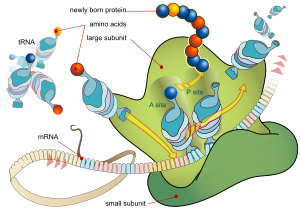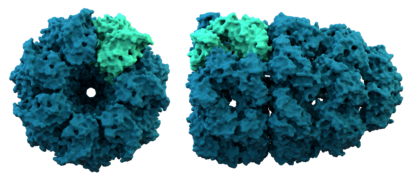Protein/ja: Difference between revisions
Created page with "===プロテオミクス=== {{Main/ja|Proteomics/ja}} このような大規模なデータセットの研究は、プロテオミクスの分野を定義しており、ゲノミクスの関連分野との類似から名付けられた。プロテオミクスの主要な実験技術には、多くのタンパク質の分離を可能にする2D電気泳動、タンパク質の迅..." Tags: Mobile edit Mobile web edit |
Created page with "===構造決定=== タンパク質の3次構造、あるいは複合体の4次構造を発見することは、タンパク質がどのようにその機能を発揮し、どのようにその機能に影響を与えることができるのか、つまり薬物設計において重要な手がかりを提供することができる。タンパク質は回折限界系:en:Optical microscope|光学顕..." Tags: Mobile edit Mobile web edit |
||
| Line 186: | Line 186: | ||
このような大規模なデータセットの研究は、[[proteome/ja|プロテオミクス]]の分野を定義しており、[[genomics/ja|ゲノミクス]]の関連分野との類似から名付けられた。[[proteomics/ja|プロテオミクス]]の主要な実験技術には、多くのタンパク質の分離を可能にする[[Two-dimensional gel electrophoresis/ja|2D電気泳動]]、タンパク質の迅速なハイスループット同定とペプチドの配列決定(多くの場合[[in-gel digestion/ja|ゲル内消化]]の後)を可能にする[[mass spectrometry/ja|質量分析]]などがある、 [[protein microarray/ja|タンパク質マイクロアレイ]]は、細胞内に存在する様々なタンパク質の相対レベルの検出を可能にし、[[two-hybrid screening/ja|ツーハイブリッドスクリーニング]]は、[[protein–protein interaction/ja|タンパク質-タンパク質相互作用]]の系統的な探索を可能にする。生物学的に可能なこのような相互作用の総体は[[interactome/ja|インタラクトーム]]として知られている。あらゆる可能性のあるフォールドを代表するタンパク質の構造を決定する体系的な試みは、[[structural genomics/ja|構造ゲノム学]]として知られている。 | このような大規模なデータセットの研究は、[[proteome/ja|プロテオミクス]]の分野を定義しており、[[genomics/ja|ゲノミクス]]の関連分野との類似から名付けられた。[[proteomics/ja|プロテオミクス]]の主要な実験技術には、多くのタンパク質の分離を可能にする[[Two-dimensional gel electrophoresis/ja|2D電気泳動]]、タンパク質の迅速なハイスループット同定とペプチドの配列決定(多くの場合[[in-gel digestion/ja|ゲル内消化]]の後)を可能にする[[mass spectrometry/ja|質量分析]]などがある、 [[protein microarray/ja|タンパク質マイクロアレイ]]は、細胞内に存在する様々なタンパク質の相対レベルの検出を可能にし、[[two-hybrid screening/ja|ツーハイブリッドスクリーニング]]は、[[protein–protein interaction/ja|タンパク質-タンパク質相互作用]]の系統的な探索を可能にする。生物学的に可能なこのような相互作用の総体は[[interactome/ja|インタラクトーム]]として知られている。あらゆる可能性のあるフォールドを代表するタンパク質の構造を決定する体系的な試みは、[[structural genomics/ja|構造ゲノム学]]として知られている。 | ||
===構造決定=== | |||
=== | タンパク質の3次構造、あるいは複合体の4次構造を発見することは、タンパク質がどのようにその機能を発揮し、どのようにその機能に影響を与えることができるのか、つまり[[Drug design/ja#Structure-based|薬物設計]]において重要な手がかりを提供することができる。タンパク質は[[:en:Diffraction-limited system|回折限界系]][[:en:Optical microscope|光学顕微鏡]]で見るには小さすぎるため、その構造を決定するには他の方法を採用しなければならない。一般的な実験手法としては、[[X-ray crystallography/ja|X線結晶構造解析]]と[[protein NMR/ja|NMR分光法]]があり、どちらも[[atom/ja|原子]]レベルの分解能で構造情報を得ることができる。しかし、NMR実験は、原子のペア間の距離のサブセットを推定するための情報を提供することができ、[[:en:distance geometry|距離幾何学]]問題を解くことによって、タンパク質の最終的なコンフォーメーションが決定される。[[Dual polarisation interferometry/ja|二重偏光干渉法]]は、全体的な[[protein conformation/ja|タンパク質のコンフォメーション]]や、相互作用や他の刺激による[[conformational change/ja|コンフォメーション変化]]を測定するための定量的分析法である。[[Circular dichroism/ja|円偏光二色性]]は、タンパク質の内部βシート/αヘリカル組成を決定するためのもう一つの実験技術である。[[:en:Cryoelectron microscopy|クライオ電子顕微鏡]]は、集合した[[ウイルス]]を含む非常に大きなタンパク質複合体に関する低分解能の構造情報を得るために用いられる;[[:en:electron crystallography|電子線結晶学]]と呼ばれる手法でも、特に膜タンパク質の二次元結晶の場合、高分解能の情報が得られる場合がある。解かれた構造は通常、[[Protein Data Bank/ja|Protein Data Bank]] (PDB)に寄託される。これは自由に利用できるリソースで、何千ものタンパク質に関する構造データを、タンパク質の各原子の[[:en:Cartesian coordinates|デカルト座標]]の形で得ることができる。 | ||
<div lang="en" dir="ltr" class="mw-content-ltr"> | <div lang="en" dir="ltr" class="mw-content-ltr"> | ||
Revision as of 10:52, 25 February 2024

タンパク質は、アミノ酸残基の1本以上の長い鎖からなる大きな大きな生体分子であり、高分子である。タンパク質は、代謝反応の触媒、DNA複製、刺激への応答、細胞への構造および生物の提供、およびある場所から別の場所への分子の輸送など、生物内で膨大な機能を果たす。タンパク質は主にアミノ酸の配列において互いに異なっており、それは遺伝子のヌクレオチド配列によって決定され、その結果、通常、タンパク質はその活性を決定する特定の3次元構造に折り畳まれる。
アミノ酸残基の直鎖をポリペプチドと呼ぶ。タンパク質は少なくとも1つの長いポリペプチドを含む。20-30残基以下の短いポリペプチドはタンパク質とみなされることはほとんどなく、一般にペプチドと呼ばれる。個々のアミノ酸残基はペプチド結合と隣接するアミノ酸残基によって結合されている。タンパク質中のアミノ酸残基の配列は、遺伝暗号にコードされた遺伝子の配列によって定義される。一般的に、遺伝暗号は20の標準アミノ酸を規定しているが、ある種の生物では遺伝暗号にセレノシステインや、ある種のarchaea/ja古細菌ではピロリジンが含まれることがある。合成後まもなく、あるいは合成中であっても、タンパク質中の残基はしばしば翻訳後修飾によって化学的に修飾される。タンパク質の中には、補欠基または補因子と呼ばれる、ペプチド以外の基が結合しているものもある。タンパク質はまた、特定の機能を達成するために協働することができ、しばしば会合して安定したタンパク質複合体を形成する。
一度形成されたタンパク質は一定期間しか存在せず、その後分解され、タンパク質のターンオーバーのプロセスを通じて細胞の機械によって再利用される。タンパク質の寿命は半減期で測定され、その範囲は広い。哺乳類の細胞では平均寿命は1〜2日で、数分間存在することもあれば数年間存在することもある。異常なタンパク質や誤った折り畳み方をしたタンパク質は、破壊の対象となるためか、不安定であるためか、より急速に分解される。
タンパク質は、多糖類や核酸などの他の生体高分子と同様に、生物にとって不可欠な部分であり、細胞内のほぼすべてのプロセスに関与している。多くのタンパク質は生化学反応を触媒する酵素であり、代謝に不可欠である。タンパク質はまた、構造的あるいは機械的な機能も持っている。例えば、筋肉のアクチンとミオシン、細胞の形を維持する足場のシステムを形成する細胞骨格のタンパク質などである。その他のタンパク質は、細胞シグナル伝達、免疫応答、細胞接着、細胞周期において重要である。動物では、タンパク質は合成できない必須アミノ酸を供給するためにダイエットに必要である。消化によってタンパク質は分解され、代謝に利用される。
タンパク質は、超遠心分離、沈殿、電気泳動、クロマトグラフィーなどの様々な技術を用いて、他の細胞成分から精製することができる。タンパク質の構造と機能を研究するために一般的に用いられる方法には、免疫組織化学、部位特異的突然変異誘発、X線結晶構造解析、核磁気共鳴、質量分析などがある。
歴史と語源
タンパク質は18世紀にAntoine Fourcroyらによって生物学的分子の別個のクラスとして認識され、熱や酸による処理下で凝固または凝集する分子の能力によって区別された。当時の有名な例としては、卵白のアルブミン、血液の血清アルブミン、フィブリン、小麦のグルテンなどが挙げられる。
タンパク質は1838年にオランダの化学者Gerardus Johannes Mulderによって初めて記述され、スウェーデンの化学者Jöns Jacob Berzeliusによって命名された。Mulderは一般的なタンパク質の元素分析を行い、ほぼすべてのタンパク質が同じ実験式、C400H620N100O120P1S1を持っていることを発見した。彼は、タンパク質は1種類の(非常に大きな)分子で構成されているのではないかという誤った結論に達した。これらの分子を表す「タンパク質」という用語は、Mulderの同僚であるBerzeliusによって提案された。タンパク質はギリシア語のπρώτειοςに由来する。(proteios)、「第一の」、「先頭に立つ」、「前に立つ」を意味し、-inに由来する。Mulderはさらに、アミノ酸などのタンパク質分解産物を特定した。ロイシンの分子量は131Daであった。「タンパク質」以前には、「アルブミン」や「アルブミン質」(ドイツ語では「Eiweisskörper」)といった別の名称が使われていた。
ドイツのカール・フォン・ヴォイトのような初期の栄養学者は、"肉は肉を作る"と一般的に信じられていたため、タンパク質が身体の構造を維持するために最も重要な栄養素であると信じていた。カール・ハインリッヒ・リトハウゼンは、グルタミン酸の同定によって、既知のタンパク質の形態を拡張した。コネチカット農業試験場で、植物性タンパク質の詳細なレビューがトーマス・バー・オズボーンによってまとめられた。ラファイエット・メンデルと協力し、実験用ラットの摂食にリービッヒの最小の法則を適用して、栄養学的に必須アミノ酸が確立された。この研究はウィリアム・カミング・ローズによって継続され、伝えられた。1902年、フランツ・ホフマイスターとヘルマン・エミール・フィッシャーの研究によって、ポリペプチドとしてのタンパク質が理解された。生物における酵素としてのタンパク質の中心的役割は、1926年にジェームズ・B・サムナーがウレアーゼという酵素が実際にタンパク質であることを示すまで、完全には理解されなかった。
タンパク質を大量に精製することは困難であったため、初期のタンパク質生化学者にとっては、非常に研究しにくいものであった。従って、初期の研究は、大量に精製できるタンパク質、例えば、血液、卵白、様々な毒素、食肉処理場から得られる消化・代謝酵素に焦点を当てた。1950年代、アーマー・ホットドッグ社は1 kgの純粋なウシ膵臓リボヌクレアーゼAを精製し、科学者が自由に利用できるようにした。このジェスチャーによって、リボヌクレアーゼAはその後数十年間、生化学研究の主要なターゲットとなった。
ライナス・ポーリングは、1933年にウィリアム・アストベリーによって初めて提唱された水素結合に基づく規則的なタンパク質の二次構造の予測に成功したことで知られている。その後、ウォルター・カウズマンによる変性に関する研究は、カイ・ウリンデルストローム=ラングによる以前の研究を部分的に基にしたものであり、疎水性相互作用によって媒介されるタンパク質の折り畳みと構造の理解に貢献した。
最初に配列されたタンパク質は、1949年、フレデリック・サンガーによるインスリンであった。サンガーはインスリンのアミノ酸配列を正確に決定し、タンパク質が分岐鎖、コロイド、シクロールではなく、アミノ酸の直鎖ポリマーから構成されていることを決定的に証明した。1958年、彼はこの功績によりノーベル賞を受賞した。

X線結晶学の発展により、タンパク質の構造配列を決定することが可能になった。最初にタンパク質構造が解明されたのは、1958年のマックス・ペルッツによるヘモグロビンとジョン・ケンドリューによるミオグロビンであった。コンピュータの使用と計算能力の向上も、複雑なタンパク質の配列決定を支えた。1999年、ロジャー・コーンバーグはシンクロトロンからの高強度X線を用いてRNAポリメラーゼの非常に複雑な構造の配列決定に成功した。
それ以来、大きな高分子集合体のクライオ電子顕微鏡(クライオEM)が開発された。クライオ電子顕微鏡は、結晶ではなく凍結したタンパク質サンプルを用い、X線ではなく電子ビームを用いる。試料へのダメージが少ないため、科学者はより多くの情報を得ることができ、より大きな構造を解析することができる。小さなタンパク質のドメインの計算によるタンパク質構造予測も、研究者がタンパク質構造の原子レベルの分解能に近づくのに役立っている。 2017年現在、プロテインデータバンクには126,060以上の原子分解能のタンパク質構造が登録されている。
ゲノムにコードされるタンパク質の数
ゲノムにコードされているタンパク質の数は、おおよそ遺伝子の数に対応する(ただし、タンパク質のRNAをコードする遺伝子、例えばリボソームRNAの数もかなり多いかもしれない)。ウイルスは通常数個から数百個、古細菌やバクテリアは数百個から数千個、真核生物は通常数千個から数万個のタンパク質をコードしている(例についてはゲノムサイズを参照)。
分類
タンパク質は主に配列と構造によって分類されるが、その他の分類も一般的に用いられている。特に酵素については、EC番号システムが機能的な分類スキームを提供している。同様に、Gene Ontology/ja遺伝子オントロジーでは、遺伝子とタンパク質の両方を生物学的・生化学的機能によって分類しているが、細胞内の位置によっても分類している。
配列の類似性は、進化的類似性と機能的類似性の両方の観点からタンパク質を分類するために使用される。特にマルチドメインタンパク質では、タンパク質全体またはタンパク質ドメインのいずれかを使用することができる。タンパク質ドメインは、配列、構造、機能の組み合わせによるタンパク質の分類を可能にし、それらは多くの異なる方法で組み合わせることができる。17万個のタンパク質を対象とした初期の研究では、約3分の2のタンパク質に少なくとも1つのドメインが割り当てられ、より大きなタンパク質ほど多くのドメインを含んでいた(例えば、600アミノ酸以上のタンパク質は平均5つ以上のドメインを持つ)。
生化学


ほとんどのタンパク質は、最大20種類のL-α-アミノ酸からなる直鎖状のポリマーから構成されている。すべてのタンパク質性アミノ酸は、α-炭素にアミノ基、カルボキシル基、および可変の側鎖が|結合しているα-炭素を含む共通の構造的特徴を持っている。プロリンだけはこの基本構造とは異なり、N末端のアミン基に変わった環を持ち、CO-NHアミド部分を固定したコンフォメーションにする。標準アミノ酸の側鎖は、標準アミノ酸リストに詳述されているが、実に多様な化学構造と性質を持っている。タンパク質の立体構造と化学反応性を最終的に決定するのは、タンパク質中のアミノ酸側鎖すべての複合効果である。 ポリペプチド鎖のアミノ酸はペプチド結合によって結合している。タンパク質鎖に連結された個々のアミノ酸は残基と呼ばれ、連結された一連の炭素、窒素、酸素原子は主鎖またはタンパク質骨格と呼ばれる。
ペプチド結合には2つの共鳴形があり、二重結合の性質を助長し、軸周りの回転を抑制するので、α炭素はほぼコプラナーになる。ペプチド結合の他の2つの二面角は、タンパク質の骨格の局所的な形状を決定する。遊離アミノ基を持つ末端はN末端またはアミノ末端として知られ、遊離カルボキシル基を持つタンパク質の末端はC末端またはカルボキシ末端として知られる(タンパク質の配列はN末端からC末端まで、左から右に書かれる)。
タンパク質、ポリペプチド、ペプチド'という言葉は少し曖昧で、意味が重複することがある。一般的にタンパク質は安定したコンフォメーションを持つ完全な生物学的分子を指すのに使われ、ペプチドは一般的に安定した三次元構造を持たないことが多い短いアミノ酸オリゴマーを指す。しかし、両者の境界は明確ではなく、通常20-30残基付近にある。ポリペプチドは、通常、長さに関係なく、アミノ酸の一本の直鎖を指すことができるが、しばしば、定義された立体構造がないことを意味する。
相互作用
タンパク質は、他のタンパク質との相互作用、脂質との相互作用、炭水化物との相互作用、DNAとの相互作用など、多くの種類の分子と相互作用することができる。
細胞内の存在量
平均的な大きさの細菌は、細胞あたり約200万個のタンパク質を含むと推定されている(例えば大腸菌や黄色ブドウ球菌)。より小さな細菌、例えばマイコプラズマやスピロヘータは、5万から100万のオーダーで、より少ない分子を含んでいる。対照的に、真核生物の細胞は大きく、そのためより多くのタンパク質を含んでいる。例えば、酵母細胞は約5000万個のタンパク質を含み、ヒト細胞は10億から30億個のオーダーであると推定されている。個々のタンパク質コピーの濃度は、細胞あたり数分子から2000万個に及ぶ。タンパク質をコードする遺伝子のすべてがほとんどの細胞で発現しているわけではなく、その数は例えば細胞の種類や外部からの刺激に左右される。例えば、ヒトゲノムがコードする20,000ほどのタンパク質のうち、リンパ芽球細胞で検出されるのは6,000だけである。
合成
生合成


タンパク質は遺伝子にコードされた情報を使ってアミノ酸から組み立てられる。各タンパク質は、そのタンパク質をコードする遺伝子のヌクレオチド配列によって規定される独自のアミノ酸配列を持っている。遺伝コードはコドンと呼ばれる3塩基の集合であり、それぞれの3塩基の組み合わせがアミノ酸を指定する。例えば、AUG(アデニン-ウラシル-グアニン)はメチオニンのコードである。DNAには4つのヌクレオチドが含まれているため、可能なコドンの総数は64である。したがって、遺伝コードには冗長性があり、複数のコドンで指定されるアミノ酸もある。DNAにコードされた遺伝子は、まずRNAポリメラーゼなどのタンパク質によってプレメッセンジャーRNA(mRNA)に転写される。ほとんどの生物はその後、様々な形の転写後修飾を用いてプレmRNA(一次転写産物とも呼ばれる)を処理して成熟mRNAを形成し、これをテンプレートとしてリボソームによるタンパク質合成を行う。原核生物では、mRNAは産生されるとすぐに使われるか、あるいはヌクレオイドから離れた後にリボソームによって結合される。一方、真核生物は細胞核でmRNAを作り、それを核膜を越えて細胞質に転移させ、そこでタンパク質生合成を行う。タンパク質合成の速度は、真核生物よりも原核生物の方が速く、1秒間に20個のアミノ酸が合成されることもある。
mRNAを鋳型としてタンパク質を合成する過程は、翻訳として知られている。mRNAはリボソームにロードされ、転移RNA分子上にあるアンチコドンと塩基対になっているコドンを一致させることで、一度に3つのヌクレオチドを読み取る。酵素アミノアシルtRNA合成酵素はtRNA分子にアミノ酸を「チャージ」する。tRNA分子に正しいアミノ酸を「チャージ」する。成長するポリペプチドはしばしば新生鎖と呼ばれる。タンパク質は常にN末端からC末端まで生合成される。
合成されたタンパク質の大きさは、含まれるアミノ酸の数とその総分子量によって測定することができ、通常はダルトン(原子質量単位と同義)または誘導体単位キロダルトン(kDa)の単位で報告される。高等生物ではタンパク質を構成するタンパク質ドメインの数が多くなるため、タンパク質の平均サイズは古細菌から細菌、真核生物へと増加する(それぞれ283, 311, 438残基、31, 34, 49 kDa)。例えば、酵母のタンパク質は平均466アミノ酸長で53kDaである。知られている最大のタンパク質は、筋肉サルコメアの構成要素であるタイチンである。分子量はほぼ3,000kDa、全長はほぼ27,000アミノ酸である。
化学合成
短いタンパク質はペプチド合成と呼ばれる一連の方法によって化学的に合成することもできる。これは化学ライゲーションなどの有機合成技術に依存して高収率でペプチドを生産する。化学合成では、アミノ酸側鎖に蛍光プローブを結合させるなど、ポリペプチド鎖に非天然アミノ酸を導入することができる。これらの方法は実験室での生化学や細胞生物学に有用であるが、しかし、一般的には商業用には使われない。化学合成は約300アミノ酸より長いポリペプチドでは効率が悪く、合成されたタンパク質は本来の三次構造をなかなかとらない。ほとんどの化学合成法は、生物学的反応とは逆に、C末端からN末端へと進む。
構造


ほとんどのタンパク質は折りたたみ独特の3次元構造になる。タンパク質が自然に折り畳まれる形は、そのネイティブコンフォメーションとして知られている。多くのタンパク質は、アミノ酸の化学的性質によって、何もしなくても折り畳むことができるが、他のタンパク質は、分子シャペロンの助けを借りなければ、本来の状態に折り畳むことができない。生化学者はしばしば、タンパク質の構造について4つの異なる側面に言及する:
- 一次構造:アミノ酸配列のことである。タンパク質はポリアミドである。
- 二次構造:水素結合によって安定化された、規則的に繰り返される局所構造。最も一般的な例は、αヘリックス、βシート、ターンである。二次構造は局所的であるため、同じタンパク質分子内に異なる二次構造の領域が多数存在しうる。
- 三次構造: タンパク質1分子の全体的な形;二次構造の空間的な相互関係。三次構造は一般に非局所的相互作用によって安定化される。最も一般的なのは疎水性コアの形成であるが、塩橋、水素結合、ジスルフィド結合、さらには翻訳後修飾によっても安定化される。三次構造という用語は、しばしばフォールドという用語と同義語として使われる。三次構造はタンパク質の基本的な機能を制御するものである。
- 四次構造: この文脈では通常タンパク質サブユニットと呼ばれる複数のタンパク質分子(ポリペプチド鎖)によって形成される構造であり、それらは単一のタンパク質複合体として機能する。
- 二項構造: 混雑した細胞内部を組織化するタンパク質表面のサインである。四大構造は、生きた細胞内で起こる、一過性でありながら不可欠な高分子相互作用に依存している。
タンパク質は完全に硬い分子ではない。これらの構造レベルに加え、タンパク質はその機能を果たす間に、いくつかの関連した構造の間を移動することがある。このような機能的転位の文脈において、これらの三次構造や四次構造は通常「コンフォーメーション」と呼ばれ、それらの間の遷移はコンフォーメーション変化と呼ばれる。このような変化は、酵素の活性部位、すなわち化学的触媒作用に関与するタンパク質の物理的領域に基質分子が結合することによって誘発されることが多い。溶液中では、タンパク質は熱振動や他の分子との衝突によっても構造が変化する。

タンパク質は非公式に3つの主要なクラスに分けることができる: 球状タンパク質、繊維状タンパク質、膜タンパク質である。ほとんどの球状タンパク質は可溶性であり、多くは酵素である。繊維状タンパク質は、結合組織の主成分であるコラーゲンや、髪や爪のタンパク質成分であるケラチンなど、構造的なタンパク質であることが多い。膜タンパク質は、しばしばレセプターとして機能したり、極性分子や荷電分子が細胞膜を通過するためのチャネルを提供したりする。
タンパク質内の分子内水素結合の特殊な例として、水からの攻撃を受けにくく、それゆえに自身の脱水を促進する、デヒドロンと呼ばれるものがある。
タンパク質ドメイン
多くのタンパク質はいくつかのタンパク質ドメインから構成されている。ドメインは通常、酵素的活性(例えば、キナーゼ)などの特定の機能も持つか、結合モジュール(例えば、SH3ドメインは他のタンパク質のプロリンに富んだ配列に結合する)として機能する。
配列モチーフ
タンパク質内の短いアミノ酸配列は、しばしば他のタンパク質の認識部位として働く。例えば、SH3ドメインは通常、短いPxxPモチーフ(すなわち、2つのプロリン[P]と2つの不特定のアミノ酸[x]で隔てられているが、周囲のアミノ酸が正確な結合特異性を決定するかもしれない)に結合する。このようなモチーフは真核生物の線形モチーフ(ELM)データベースに多数収集されている。
===タンパク質のトポロジー タンパク質のトポロジーは、骨格のもつれや折り畳まれた鎖内の接点の配置を記述する。タンパク質のトポロジーを特徴付けるために、結び目理論と回路トポロジーの2つの理論的枠組みが適用されている。タンパク質のトポロジーを記述できるようになることで、タンパク質工学や医薬品開発に新たな道が開かれ、神経筋疾患やがんなどのタンパク質のミスフォールディング疾患に対する理解が深まる。
細胞機能
タンパク質は細胞内の主役であり、遺伝子にコードされた情報によって指定された任務を遂行していると言われている。ある種のRNAを除いて、他のほとんどの生体分子はタンパク質が作用する比較的不活性な要素である。タンパク質は、大腸菌細胞の乾燥重量の半分を占めるが、DNAやRNAのような他の高分子はそれぞれ3%と20%に過ぎない。特定の細胞や細胞型で発現するタンパク質の集合は、そのプロテオームとして知られている。

タンパク質の最大の特徴は、他の分子と特異的かつ強固に結合できることである。他の分子と結合するタンパク質の領域は結合部位と呼ばれ、多くの場合、分子表面の窪みや「ポケット」である。この結合能力は、結合部位ポケットを規定するタンパク質の三次構造と、周囲のアミノ酸側鎖の化学的性質によって媒介される。例えば、リボヌクレアーゼ阻害剤タンパク質はヒトのアンジオジェニンとはフェムトモル以下の解離定数(<10-15 M)で結合するが、両生類のホモログであるオンコナーゼ(>1 M)とは全く結合しない。例えば、アミノ酸バリンに特異的なアミノアシルtRNA合成酵素は、アミノ酸イソロイシンの非常によく似た側鎖を識別する。
タンパク質は低分子基質だけでなく、他のタンパク質とも結合することができる。タンパク質が同じ分子の他のコピーと特異的に結合すると、オリゴマー化して線維を形成することができる。この過程は、自己会合して硬い線維を形成する球状モノマーからなる構造タンパク質でしばしば起こる。タンパク質-タンパク質相互作用はまた、酵素活性を調節し、細胞周期の進行を制御し、共通の生物学的機能を持つ多くの密接に関連した反応を実行する大きなタンパク質複合体の集合を可能にする。タンパク質はまた、細胞膜に結合したり、細胞膜に組み込まれたりすることもある。結合パートナーはタンパク質の構造変化を引き起こすことができるため、非常に複雑なシグナル伝達ネットワークを構築することができる。 タンパク質間の相互作用は可逆的であり、個別の機能を実行することができる凝集体を形成するために、異なるグループのパートナータンパク質が利用できるかどうかに大きく依存するため、特定のタンパク質間の相互作用を研究することは、細胞機能の重要な側面、ひいては特定の細胞タイプを区別する特性を理解するための鍵となる。
酵素
細胞内におけるタンパク質の最もよく知られた役割は、化学反応を触媒する酵素としての役割である。酵素は通常、非常に特異的であり、1つまたは少数の化学反応のみを促進する。酵素は代謝に関わる反応のほとんどを行うだけでなく、DNA複製、DNA修復、転写などの過程でDNAを操作する。一部の酵素は、翻訳後修飾として知られるプロセスにおいて、他のタンパク質に作用して化学基を付加したり除去したりする。約4,000の反応が酵素によって触媒されることが知られている。酵素触媒作用によってもたらされる反応速度の加速は、しばしば莫大なものであり、オロチン酸脱炭酸酵素の場合、触媒作用のない反応に比べて1017倍の速度増加が見られる(酵素なしでは7800万年、酵素ありでは18ミリ秒)。
酵素が結合し作用する分子はSubstrate (biochemistry)/ja基質と呼ばれる。酵素は何百ものアミノ酸から構成されることがあるが、通常、基質と接触する残基はごく一部であり、触媒反応に直接関与する残基はさらにごく一部である。 基質と結合し、触媒残基を含む酵素の領域は活性部位として知られている。
ディリゲントタンパク質は、他の酵素によって合成された化合物の立体化学を決定するタンパク質の一種である。
細胞シグナル伝達とリガンド結合

多くのタンパク質が細胞シグナル伝達やシグナル伝達の過程に関与している。インスリンのようないくつかのタンパク質は、それが合成された細胞から離れた組織の他の細胞にシグナルを伝達する細胞外タンパク質である。他のものは膜タンパク質で、レセプターとして働き、その主な機能はシグナル伝達分子と結合して細胞内の生化学的反応を誘導することである。多くのレセプターは、細胞表面に露出した結合部位と細胞内のエフェクタードメインを持ち、酵素活性を持つこともあれば、細胞内の他のタンパク質によって検出される構造変化を起こすこともある。
抗体は適応免疫系のタンパク質成分であり、その主な機能は抗原、すなわち体内の異物と結合し、破壊の対象とすることである。抗体は細胞外環境に分泌されるか、形質細胞として知られる特殊なB細胞の膜に固定される。酵素が反応を行う必要性から基質との結合親和性に制約があるのに対し、抗体にはそのような制約はない。抗体の標的に対する結合親和性は非常に高い。
多くのリガンド輸送タンパク質は、特定の|低分子生体分子と結合し、多細胞生物の体内の別の場所に輸送する。これらのタンパク質は、リガンドが高濃度で存在するときには高い結合親和性を持たなければならないが、標的組織中に低濃度で存在するときにはリガンドを放出しなければならない。リガンド結合タンパク質の典型例はヘモグロビンであり、すべての脊椎動物の肺から他の臓器や組織に酸素を輸送する。レクチンは糖結合タンパク質であり、その糖鎖部分に非常に特異的である。レクチンは通常、細胞やタンパク質が関与する生物学的な認識現象において役割を果たす。受容体やホルモンは特異性の高い結合タンパク質である。
膜貫通タンパク質は、小分子やイオンに対する細胞膜の透過性を変化させるリガンド輸送タンパク質としても機能する。膜だけでは疎水性コアがあり、そこを極性分子や荷電分子は拡散できない。膜タンパク質は、そのような分子が細胞内に出入りするための内部チャネルを含んでいる。例えば、カリウムチャネルとナトリウムチャネルは、しばしば2つのイオンのうち一方のみを識別する。
構造タンパク質
構造タンパク質は、本来は流動的な生体構成要素に硬さと剛性を与える。ほとんどの構造タンパク質は線維状タンパク質であり、例えばコラーゲンやエラスチンは結合組織、例えば軟骨の重要な構成要素であり、ケラチンは髪、爪、羽毛、ひづめ、およびいくつかの動物の殻などの硬いまたは繊維状の構造に見られる。球状タンパク質の中にも構造的な役割を果たすものがあります。例えば、アクチンやチューブリンは球状で単量体として可溶性であるが、重合して長くて硬い繊維を形成し、細胞骨格を構成し、これによって細胞はその形状とサイズを維持できる。
構造的機能を果たす他のタンパク質としては、ミオシン、キネシン、ダイニンなどのモータータンパク質があり、これらは機械的な力を発生させることができる。これらのタンパク質は、単細胞生物の細胞運動性や、有性生殖を行う多くの多細胞生物の精子にとって極めて重要である。また、筋肉の収縮によって発揮される力を生み出し、細胞内輸送において重要な役割を果たす。
タンパク質の進化
分子生物学における重要な疑問は、タンパク質がどのように進化するのか、すなわちどのようにして突然変異(というよりアミノ酸配列の変化)が新しい構造や機能をもたらすのか、ということである。タンパク質中のほとんどのアミノ酸は、活性や機能を破壊することなく変化させることができる。これは、種を超えた数多くの相同性タンパク質(タンパク質ファミリーの専門データベース、例えばPFAMに収集されている)からわかる。突然変異の劇的な結果を防ぐために、遺伝子は自由に突然変異を起こす前に複製されることがある。しかし、これは遺伝子の機能を完全に失わせることになり、その結果偽遺伝子を引き起こすこともある。 より一般的には、単一のアミノ酸の変化は、特に酵素においてはタンパク質の機能を大きく変えるものもあるが、その影響は限定的である。例えば、多くの酵素は、1つまたは数個の変異によって、その基質特異性を変えることができる。基質特異性の変化は、基質多様性、すなわち多くの酵素が複数の基質に結合して処理する能力によって促進される。変異が起こると、酵素の特異性は増加し(または減少し)、その結果酵素活性も増加する。変異が起こると、酵素の特異性が高まり(あるいは低下し)、その結果酵素活性が高まる。こうしてバクテリア(あるいは他の生物)は、プラスチックのような不自然な基質を含む、さまざまな食物源に適応することができる。
研究方法
タンパク質の活性と構造は、試験管内、生体内、シリコンウェハ内で調べることができる。精製したタンパク質を制御された環境で試験管内で培養する研究は、タンパク質がどのように機能を発揮するかを知る上で有用である:例えば、酵素動力学研究では、酵素の触媒活性の化学的メカニズムや、様々な基質分子に対する相対的な親和性を探る。対照的に、生体内実験では、細胞あるいは生物全体におけるタンパク質の生理的役割に関する情報を得ることができる。シリコンウェア内研究は、タンパク質を研究するために計算手法を用いる。
タンパク質の精製
試験管内分析を行うには、タンパク質を他の細胞成分から分離して精製する必要がある。このプロセスは通常細胞溶解から始まり、細胞膜が破壊され、粗溶解液として知られる溶液中に細胞内内容物が放出される。得られた混合物は超遠心分離を用いて精製することができ、様々な細胞成分を可溶性タンパク質、膜脂質およびタンパク質、細胞オルガネラ、および核酸を含む画分に分画する。塩析として知られる方法で沈殿させると、この溶解液からタンパク質を濃縮することができる。次に、分子量、正味電荷、結合親和性などの特性に基づいて、目的のタンパク質またはタンパク質を単離するために、様々な種類のクロマトグラフィーが用いられる。目的のタンパク質の分子量と等電点が既知であればゲル電気泳動で、タンパク質が識別可能な分光学的特徴を有していれば分光学で、タンパク質が酵素活性を有していれば酵素アッセイで、精製レベルをモニターすることができる。さらに、エレクトロフォーカシングを用いて、タンパク質をその電荷に応じて単離することもできる。
天然のタンパク質の場合、実験室での使用に十分な純度のタンパク質を得るためには、一連の精製工程が必要になることがある。このプロセスを簡略化するために、遺伝子工学はしばしば、タンパク質の構造や活性に影響を与えずに精製を容易にする化学的特徴をタンパク質に付加するために用いられる。この場合、特定のアミノ酸配列からなる「タグ」、多くの場合は一連のヒスチジン残基(His-tag)がタンパク質の一方の末端に付加される。その結果、溶解液をニッケルを含むクロマトグラフィーカラムにかけると、ヒスチジン残基がニッケルに結合してカラムに付着し、溶解液中のタグのない成分はそのまま通過する。複雑な混合物から特定のタンパク質を精製するために、多くの異なるタグが開発されている。
細胞コンパートメント

タンパク質の生体内研究は、多くの場合、細胞内でのタンパク質の合成と局在に関係している。多くの細胞内タンパク質は細胞質で合成され、膜結合タンパク質や分泌タンパク質は小胞体で合成されるが、タンパク質がどのようにして特定の小器官や細胞構造に標的化されるかの詳細は不明なことが多い。細胞局在を評価するための有用な技術は、遺伝子工学を用いて、目的の天然タンパク質と緑色蛍光タンパク質(GFP)のような"レポーター"とが結合した融合タンパク質あるいはキメラを細胞内で発現させることである。融合タンパク質の細胞内での位置は、反対側の図に示すように、顕微鏡を使ってきれいかつ効率的に可視化することができる。
タンパク質の細胞内局在を解明する他の方法では、小胞体、ゴルジ体、リソソームや液胞、ミトコンドリア、葉緑体、細胞膜などの領域について、既知のコンパートメントマーカーを使用する必要がある。これらのマーカーに蛍光タグを付けたものや、既知のマーカーに対する抗体を用いることで、目的のタンパク質の局在を同定することがより簡単になる。例えば、間接免疫蛍光法を用いれば、蛍光の共局在化と局在の証明が可能になる。蛍光色素は、同様の目的で細胞区画を標識するために用いられる。
他の可能性も存在する。例えば、免疫組織化学では通常、1つ以上の目的のタンパク質に対する抗体を使用し、酵素と結合させて発光シグナルまたは発色シグナルを得る。もう一つの適用可能な手法は、アイソピクニック遠心分離を用いたスクロース(または他の物質)勾配での共分離である。この技術は、既知の密度のコンパートメントと目的のタンパク質の共局在を証明するものではないが、可能性は高く、大規模な研究に適している。
最後に、細胞局在化の最も標準的な方法は、免疫電子顕微鏡法である。この手法も、古典的な電子顕微鏡法とともに、目的のタンパク質に対する抗体を用いる。試料は通常の電子顕微鏡検査用に調製され、次に極めて電気密度の高い物質(通常は金)に結合した目的のタンパク質に対する抗体で処理される。これにより、超微細構造の詳細と目的タンパク質の局在の両方を観察することができる。
部位特異的突然変異誘発として知られるもうひとつの遺伝子工学的応用によって、研究者はタンパク質の配列を変えることができ、それによってその構造、細胞局在性、制御に対する感受性を変えることができる。この技術によって、改変されたtRNAを用いて非天然アミノ酸をタンパク質に組み込むことも可能になり、新しい性質を持つタンパク質を合理的にデザインできるようになるかもしれない。
プロテオミクス
このような大規模なデータセットの研究は、プロテオミクスの分野を定義しており、ゲノミクスの関連分野との類似から名付けられた。プロテオミクスの主要な実験技術には、多くのタンパク質の分離を可能にする2D電気泳動、タンパク質の迅速なハイスループット同定とペプチドの配列決定(多くの場合ゲル内消化の後)を可能にする質量分析などがある、 タンパク質マイクロアレイは、細胞内に存在する様々なタンパク質の相対レベルの検出を可能にし、ツーハイブリッドスクリーニングは、タンパク質-タンパク質相互作用の系統的な探索を可能にする。生物学的に可能なこのような相互作用の総体はインタラクトームとして知られている。あらゆる可能性のあるフォールドを代表するタンパク質の構造を決定する体系的な試みは、構造ゲノム学として知られている。
構造決定
タンパク質の3次構造、あるいは複合体の4次構造を発見することは、タンパク質がどのようにその機能を発揮し、どのようにその機能に影響を与えることができるのか、つまり薬物設計において重要な手がかりを提供することができる。タンパク質は回折限界系光学顕微鏡で見るには小さすぎるため、その構造を決定するには他の方法を採用しなければならない。一般的な実験手法としては、X線結晶構造解析とNMR分光法があり、どちらも原子レベルの分解能で構造情報を得ることができる。しかし、NMR実験は、原子のペア間の距離のサブセットを推定するための情報を提供することができ、距離幾何学問題を解くことによって、タンパク質の最終的なコンフォーメーションが決定される。二重偏光干渉法は、全体的なタンパク質のコンフォメーションや、相互作用や他の刺激によるコンフォメーション変化を測定するための定量的分析法である。円偏光二色性は、タンパク質の内部βシート/αヘリカル組成を決定するためのもう一つの実験技術である。クライオ電子顕微鏡は、集合したウイルスを含む非常に大きなタンパク質複合体に関する低分解能の構造情報を得るために用いられる;電子線結晶学と呼ばれる手法でも、特に膜タンパク質の二次元結晶の場合、高分解能の情報が得られる場合がある。解かれた構造は通常、Protein Data Bank (PDB)に寄託される。これは自由に利用できるリソースで、何千ものタンパク質に関する構造データを、タンパク質の各原子のデカルト座標の形で得ることができる。
Many more gene sequences are known than protein structures. Further, the set of solved structures is biased toward proteins that can be easily subjected to the conditions required in X-ray crystallography, one of the major structure determination methods. In particular, globular proteins are comparatively easy to crystallize in preparation for X-ray crystallography. Membrane proteins and large protein complexes, by contrast, are difficult to crystallize and are underrepresented in the PDB. Structural genomics initiatives have attempted to remedy these deficiencies by systematically solving representative structures of major fold classes. Protein structure prediction methods attempt to provide a means of generating a plausible structure for proteins whose structures have not been experimentally determined.
構造予測

構造ゲノミクスの分野を補完するものとして、タンパク質構造予測は、タンパク質の効率的な数学モデルを開発し、実験室での観察によって構造を検出する代わりに、理論的に分子形成を計算で予測する。相同性モデリングとして知られる構造予測の最も成功したタイプは、モデル化されるタンパク質と配列が類似している「鋳型」構造の存在に依存している。構造ゲノミクスの目標は、残された構造のほとんどをモデル化するために、解決された構造に十分な表現を提供することである。遠縁のテンプレート構造しか利用できない場合、正確なモデルを作成することは依然として困難であるが、配列アライメントがこのプロセスのボトルネックであることが示唆されている。多くの構造予測手法は、タンパク質工学という新たな分野への情報提供に役立っており、そこではすでに新規なタンパク質フォールドが設計されている。また、タンパク質(真核生物では〜33%)には、構造化されていないが生物学的に機能する大きな部分があり、本質的に無秩序なタンパク質として分類される。したがって、タンパク質の無秩序を予測・解析することは、タンパク質構造解析の重要な一部である。
バイオインフォマティクス
タンパク質の構造、機能、進化を解析するために、膨大な数の計算手法が開発されてきた。このようなツールの開発は、ヒトゲノムを含む様々な生物について利用可能な大量のゲノムおよびプロテオミクスデータによって推進されてきた。すべてのタンパク質を実験的に研究することは不可能であるため、実験室での実験に供されるのはごく一部であり、計算ツールを用いて類似タンパク質を推定することが行われている。このような相同タンパク質は、配列アライメントによって遠縁の生物で効率的に同定することができる。ゲノムや遺伝子の配列は、ある特定の性質について様々なツールで検索することができる。配列プロファイリングツールは制限酵素部位やヌクレオチド配列中のオープンリーディングフレームを見つけ、二次構造を予測することができる。系統樹を構築し、ClustalWのような特別なソフトウェアを使って、現代の生物の祖先とそれらが発現する遺伝子に関する進化仮説を立てることができる。遺伝子やタンパク質の解析には、今やバイオインフォマティクスの分野が欠かせない。
動的過程のインシリコシミュレーション
より複雑な計算問題は、分子ドッキング、タンパク質フォールディング、タンパク質間相互作用、化学反応性などの分子間相互作用の予測である。これらの動的過程をシミュレートする数理モデルには、分子力学、特に分子動力学が関与している。このような観点から、ビリンヘッドピースやHIVアクセサリータンパク質のような小さなα-ヘリカルタンパク質ドメインのフォールディングを発見したシリコンチップ内'シミュレーションや、標準的な分子動力学と量子力学数学を組み合わせたハイブリッド手法によって、ロドプシンの電子状態が探求されている。
古典的な分子動力学にとどまらず、量子動力学手法を用いれば、量子力学的効果を正確に記述した上で、原子レベルの詳細なタンパク質のシミュレーションを行うことができる。例えば、多層多構成時間依存ハートリー(MCTDH)法や階層的運動方程式(HEOM)アプローチなどがある、 これらはそれぞれ植物のクリプトクロムとバクテリアの光捕集複合体に適用されている。 生物学的なスケールのシステムの両方の量子力学的および古典力学的なシミュレーションは非常に計算コストがかかるため、Folding@homeプロジェクトのような分散コンピューティングイニシアティブが、GPUの並列処理やモンテカルロ技術の進展を活用して分子モデリングを容易にしている。
化学分析
有機物の総窒素含有量は主にタンパク質中のアミノ基によって形成される。総ケルダール窒素(TKN)は、(廃)水、土壌、食品、飼料、および一般的には有機物の分析で広く使用される窒素の指標である。その名前が示すように、Kjeldahl法が適用される。より感度の高い方法も利用可能である。
栄養
ほとんどの微生物と植物は20種類すべての標準的なアミノ酸を生合成することができるが、動物(ヒトを含む)はアミノ酸の一部を食事から摂取しなければならない。生物が自力で合成できないアミノ酸は必須アミノ酸と呼ばれる。例えば、アスパラギン酸からリジン、メチオニン、スレオニンの合成の第一段階を触媒するアスパルトキナーゼなどである。環境中にアミノ酸が存在する場合、微生物は周囲からアミノ酸を取り込み、生合成経路をダウンレギュレーションすることでエネルギーを節約することができる。
動物では、アミノ酸はタンパク質を含む食物を摂取することで得られる。摂取されたタンパク質は消化によってアミノ酸に分解されるが、この消化には通常、酸にさらされることによるタンパク質の変性と、プロテアーゼと呼ばれる酵素による加水分解が含まれる。摂取されたアミノ酸の一部はタンパク質の生合成に使われ、他のアミノ酸は糖新生によってグルコースに変換されるか、クエン酸サイクルに供給される。このようにタンパク質を燃料として利用することは、飢餓状態において特に重要である。特に筋肉に含まれるタンパク質がそうである。
犬や猫などの動物では、タンパク質は毛包の成長と角化を促進することで皮膚の健康と質を維持し、悪臭を発生させる皮膚トラブルの可能性を減らす。質の悪いタンパク質は胃腸の健康にも関与し、犬の鼓腸や悪臭の可能性を高める。タンパク質が未消化の状態で大腸に到達すると、発酵して硫化水素ガス、インドール、スカトールが発生するからだ。犬や猫の動物性タンパク質は植物性タンパク質よりも消化が良いが、低品質の動物性タンパク質は消化が悪く、皮膚、羽毛、結合組織などが含まれる。
こちらも参照
さらに読む
- 教科書
- Branden C, Tooze J (1999). Introduction to Protein Structure. New York: Garland Pub. ISBN 978-0-8153-2305-1.
- Murray RF, Harper HW, Granner DK, Mayes PA, Rodwell VW (2006). Harper's Illustrated Biochemistry. New York: Lange Medical Books/McGraw-Hill. ISBN 978-0-07-146197-9.
- Van Holde KE, Mathews CK (1996). Biochemistry. Menlo Park, California: Benjamin/Cummings Pub. Co., Inc. ISBN 978-0-8053-3931-4.
外部リンク
データベースとプロジェクト
- NCBI Entrez Protein database
- NCBI Protein Structure database
- Human Protein Reference Database
- Human Proteinpedia
- Folding@Home (Stanford University) Archived 2012-09-08 at the Wayback Machine
- Protein Databank in Europe (see also PDBeQuips, short articles and tutorials on interesting PDB structures)
- Research Collaboratory for Structural Bioinformatics (see also Molecule of the Month Archived 2020-07-24 at the Wayback Machine, presenting short accounts on selected proteins from the PDB)
- Proteopedia – Life in 3D: rotatable, zoomable 3D model with wiki annotations for every known protein molecular structure.
- UniProt the Universal Protein Resource
チュートリアルと教育ウェブサイト
- "An Introduction to Proteins" from HOPES (Huntington's Disease Outreach Project for Education at Stanford)
- Proteins: Biogenesis to Degradation – The Virtual Library of Biochemistry and Cell Biology